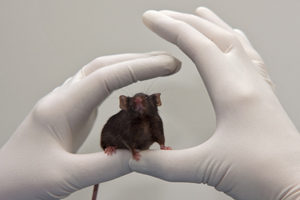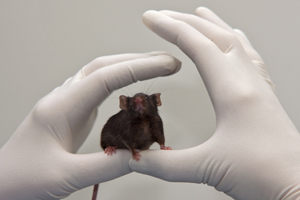
Laboratory Animal Diets
Laboratory animals are in a special situation. The animal technicians, veterinarians, environment engineers and feed suppliers must provide all of their normal daily requirements. We take this responsibility seriously, balancing the nutritional requirements of the animals whilst still providing a stable work platform for the experimental scientists. We have been making diets for Laboratory animals for more than 15 years. For this special sector of feed suppliers our relatively small size is an advantage. We are situated close to a major grain growing region and can source our grains from a small number of farms. This helps to reduce the normal variability in natural raw materials. We take an equal care in selecting the ingredients of diets that must be sourced externally. Back to Top
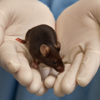
Rats and Mice Standard Diets
Back to Top
Rat and Mouse Cubes ( SF00-100 )
A fixed formulation diet for Laboratory Rats and Mice fortified with vitamins and minerals to meet the requirements of breeding animals after the diet is autoclaved or irradiated.
- All nutritional parameters of this diet meet or exceed the NRC guidelines for Rats and Mice.
- The diet has been designed as a general ration for breeding and early growth in all rat and mouse strains. The total fat content has been deliberately kept low at around 5%, to maximize the long term breeding performance of most strains.
- The formulation is designed to be fed ad-lib to rodents of all ages. There is some indication that growth performance in a minority of strains can be improved by increasing dietary energy (fat content). BalbC mice, DA rats and some of the modified strains appear to be most susceptible to this problem. Please contact us if you are concerned about this issue.
- Mammalian meals have been excluded from the diet, however the diet does contain fish meal. We have formulated totally vegetarian diets, and maintained colonies for some time on these diets. Please contact us if you require such a diet.
- The feed is manufactured in a cylindrical form with a diameter of around 12 mm, length is variable from 10 mm to 30 mm. We have found that this form is ideal for overhead hopper feeding, maximizing the ease of handling whilst minimizing fines formation and the risk of bridging in the feed hopper. Pellet strength has been kept lower than conventional pelletised diets. While this leads to a slight increase in transit and storage damage to the diet (fines generation), we have found that juvenile mice often have a lower feed intake on harder pellets.
- The diet is packed in permeable bags suitable for direct loading into an autoclave. It is recommended that the diet be autoclaved at 120o C for 20 minutes with a post autoclaving vacuum drying cycle. Some clumping of the diet can be expected, but the diet clumps can usually be easily broken. Modifying the drying time to leave some residual moisture in the diet can minimize the clumping. Do not autoclave at 135o C as this will result in significant clumping that will be difficult to break.
Back to Top
Maintenance Rat and Mouse Cubes

A fixed formulation diet for Laboratory Rats and Mice fortified with vitamins and minerals to meet the requirements of maintenance animals after the diet is autoclaved or irradiated.
- All nutritional parameters of this diet meet or exceed the NRC maintenance guidelines for Rats and Mice.
- The diet has been designed as a maintenance ration for non breeding mature rodents.
- Protein content has been reduced from 19% in the standard ration to 15%.
- The diet has been designed as a maintenance ration for non breeding mature rodents.
- Calculated energy has been reduced from 14.3 MJ/Kg to 13 MJ/Kg
- Mineral content has been changed from the standard ration, reducing Ca and P but maintaining the Ca:P ratio
- Mammalian meals have been excluded from the diet, however the diet does contain fish meal. We have formulated totally vegetarian diets, and maintained colonies for some time on these diets. Please contact us if you require such a diet.
- The feed is manufactured in a cylindrical form with a diameter of around 12 mm, length is variable from 10 mm to 30 mm. We have found that this form is ideal for overhead hopper feeding, maximizing the ease of handling whilst minimizing fines formation and the risk of bridging in the feed hopper. Pellet strength has been kept lower than conventional pelletised diets. While this leads to a slight increase in transit and storage damage to the diet (fines generation), we have found that juvenile mice often have a lower feed intake on harder pellets.
- The diet is packed in permeable bags suitable for direct loading into an autoclave. It is recommended that the diet be autoclaved at 120o C for 20 minutes with a post autoclaving vacuum drying cycle. Some clumping of the diet can be expected, but the diet clumps can usually be easily broken. Modifying the drying time to leave some residual moisture in the diet can minimize the clumping. Do not autoclave at 135o C as this will result in significant clumping that will be difficult to break.
Back to Top
Irradiated Rat and Mouse Cubes ( SF00-100 Irr)
A fixed formulation diet for Laboratory Rats and Mice fortified with vitamins and minerals to meet the requirements of breeding animals.
- This diet has identical specifications to our autoclavable standard Rat and Mouse ration.
- The diet is vacuum packed in three layers of packaging, the first layer being a paper liner followed by two separate layers of low oxygen permeability plastic. The bags are packed in an outer cardboard box then irradiated at 25KGy. The irradiation operation has an extensive quality control process to ensure each carton has received the required dose.
- All nutritional parameters of this diet meet or exceed the NRC guidelines for Rats and Mice.
- The diet has been designed as a general ration for breeding and early growth in all rat and mouse strains. The total fat content has been deliberately kept low at around 5%, to maximize the long term breeding performance of most strains.
- The formulation is designed to be fed ad-lib to rodents of all ages. There is some indication that growth performance in a minority of strains can be improved by increasing dietary energy (fat content). BalbC mice, DA rats and some of the modified strains appear to be most susceptible to this problem. Please contact us if you are concerned about this issue.
- Mammalian meals have been excluded from the diet, however the diet does contain fish meal. We have formulated totally vegetarian diets, and maintained colonies for some time on these diets. Please contact us if you require such a diet.
- The feed is manufactured in a cylindrical form with a diameter of around 12 mm, length is variable from 10 mm to 30 mm. We have found that this form is ideal for overhead hopper feeding, maximizing the ease of handling whilst minimizing fines formation and the risk of bridging in the feed hopper. Pellet strength has been kept lower than conventional pelletised diets. While this leads to a slight increase in transit and storage damage to the diet (fines generation), we have found that juvenile mice often have a lower feed intake on harder pellets.
Back to Top
Vegetarian Rat and Mouse Cubes

A vegetarian fixed formulation diet for Laboratory Rats and Mice, free of any meat or fish products, fortified with vitamins and minerals to meet the requirements of breeding animals after the diet is autoclaved or irradiated.
- This formulation excludes all meat and fish meals but has very similar nutritional specifications to the Standard Meat Free Rat and Mouse
- All nutritional parameters of this diet meet or exceed the NRC guidelines for Rats and Mice.
- The diet has been designed as a general ration for breeding and early growth in all rat and mouse strains. The total fat content has been deliberately kept low at around 5%, to maximize the long term breeding performance of most strains.
- The formulation is designed to be fed ad-lib to rodents of all ages. There is some indication that growth performance in a minority of strains can be improved by increasing dietary energy (fat content). BalbC mice, DA rats and some of the modified strains appear to be most susceptible to this problem. Please contact us if you are concerned about this issue.
- Mammalian meals have been excluded from the diet, however the diet does contain fish meal. We have formulated totally vegetarian diets, and maintained colonies for some time on these diets. Please contact us if you require such a diet.
- The feed is manufactured in a cylindrical form with a diameter of around 12 mm, length is variable from 10 mm to 30 mm. We have found that this form is ideal for overhead hopper feeding, maximizing the ease of handling whilst minimizing fines formation and the risk of bridging in the feed hopper. Pellet strength has been kept lower than conventional pelletised diets. While this leads to a slight increase in transit and storage damage to the diet (fines generation), we have found that juvenile mice often have a lower feed intake on harder pellets.
- The diet is packed in permeable bags suitable for direct loading into an autoclave. It is recommended that the diet be autoclaved at 120o C for 20 minutes with a post autoclaving vacuum drying cycle. Some clumping of the diet can be expected, but the diet clumps can usually be easily broken. Modifying the drying time to leave some residual moisture in the diet can minimize the clumping. Do not autoclave at 135o C as this will result in significant clumping that will be difficult to break.
Back to Top
Controlled High Gluten Rat and Mouse

A fixed formulation diet for Laboratory Rats and Mice fortified with vitamins and minerals to meet the
requirements of breeding animals after the diet is autoclaved or irradiated.
- All nutritional parameters of this diet meet or exceed the NRC guidelines for Rats and Mice.
- The diet has been designed specifically for non obese diabetic (NOD) mice, keeping gluten content consistently high.
- The only grains included in the ration are maize and lupins. All gluten comes from a semi-refined
wheat gluten - The formulation is designed to be fed ad-lib to rodents of all ages.
- Mammalian and fish meals have been excluded from the diet.
- Total protein content has been increased to 23% as compared to the standard ration of
around 19 – 20%. For mature animals it may be necessary to reduce the total protein specification. This could only be done by reducing the gluten content. - There is a small increase in the energy density of the diet as compared to the standard ration
(14.8 MJ/Kg vs 14.4 MJ/Kg in the standard diet). Again it may be necessary to reduce this for mature animals. This could only be done by reducing gluten content. - The feed is manufactured in a cylindrical form with a diameter of around 12 mm, length is variable from 10 mm to 30 mm. We have found that this form is ideal for overhead hopper feeding, maximizing the ease of handling whilst minimizing fines formation and the risk of bridging in the feed hopper. Pellet strength has been kept lower than conventional pelletised diets. While this leads to a slight increase in transit and storage damage to the diet (fines generation), we have found that juvenile mice often have a lower feed intake on harder pellets.
- The diet is packed in permeable bags suitable for direct loading into an autoclave. It is recommended that the diet be autoclaved at 120o C for 20 minutes with a post autoclaving vacuum drying cycle. Some clumping of the diet can be expected, but the diet clumps can usually be easily broken. Modifying the drying time to leave some residual moisture in the diet can minimize the clumping. Do not autoclave at 135o C as this will result in significant clumping that will be difficult to break.
Keywords: nod mice, nod2,
Back to Top
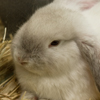
Rabbit Standard Diets
Back to Top
Guinea Pig and Rabbit Pellets

A fixed formulation diet for Laboratory Guinea Pigs and Rabbits fortified with vitamins and minerals
to meet the requirements of breeding animals after the diet is autoclaved or irradiated. Reformulated
2014.
• PLEASE NOTE: Diet was reformulated in 2014 to include Vitamin C. NO other changes
have been made to the formulation
• This hybrid diet has been used successfully in a number of breeding and maintenance
facilities for many years however the diet is designed to be fed in conjunction with fresh green
feedstuffs. If feeding alone a high energy Guinea Pig diet and a high fibre Rabbit Pellet are
available.
• If the diet is to be autoclaved, the recommended conditions are: Autoclave at 120°C for 20
minutes with a post autoclaving vacuum drying cycle. Some clumping of the diet can be
expected, but the diet clumps can usually be easily broken. Modifying the drying time to leave
some residual moisture in the diet can minimise the clumping. Do not autoclave at 135°C as
this will result in significant clumping that will be difficult to break.
Back to Top
High Fibre Rabbit Pellets

A diet for Laboratory Rabbits fortified with vitamins and minerals to meet the requirements of these animals after the diet is autoclaved or irradiated.
- Feed is designed to be fed ad-lib to animals of all ages, as a complete diet
- The diet is manufactured as a 4 mm diameter pellet, 4 – 10 mm long.
- Packaging is in 10 Kg or 20 Kg woven polyethylene bags suitable for direct loading into an autoclave.
- If the diet is to be autoclaved, the recommended conditions are: Autoclave at 120 C for 20 minutes with a post autoclaving vacuum drying cycle. Some clumping of the diet can be expected, but the diet clumps can usually be easily broken. Modifying the drying time to leave some residual moisture in the diet can minimize the clumping. Do not autoclave at 135 C as this will result in significant clumping that will be difficult to break.
Back to Top
Rabbit Muesli

A complete and balanced diet designed for rabbit of all ages.
- Contains chaff, Lucerne, steam rolled barley, steam rolled lupins, micronized maize, sunflower and a vitamin and mineral pellet.
- Packaging is in 25 Kg woven polyethylene bags, 4 Kg plastic bags or 2 Kg plastic bags.
Back to Top
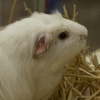
Guinea Pig Standard Diets
Back to Top
Guinea Pig and Rabbit Pellets

A fixed formulation diet for Laboratory Guinea Pigs and Rabbits fortified with vitamins and minerals
to meet the requirements of breeding animals after the diet is autoclaved or irradiated. Reformulated
2014.
• PLEASE NOTE: Diet was reformulated in 2014 to include Vitamin C. NO other changes
have been made to the formulation
• This hybrid diet has been used successfully in a number of breeding and maintenance
facilities for many years however the diet is designed to be fed in conjunction with fresh green
feedstuffs. If feeding alone a high energy Guinea Pig diet and a high fibre Rabbit Pellet are
available.
• If the diet is to be autoclaved, the recommended conditions are: Autoclave at 120°C for 20
minutes with a post autoclaving vacuum drying cycle. Some clumping of the diet can be
expected, but the diet clumps can usually be easily broken. Modifying the drying time to leave
some residual moisture in the diet can minimise the clumping. Do not autoclave at 135°C as
this will result in significant clumping that will be difficult to break.
Back to Top
High Energy Guinea Pig Pellets

A Guinea Pig diet specifically designed for breeding colonies where fresh supplementary feeds are not used.
- Energy has been increased by around 10% over the standard diet. Protein has been increased slightly, fibre reduced, lipid energy increased and carbohydrate energy maintained. Lipid source has been broadened to maximise range of fatty acids and maximise polar lipids (important precursors for prostaglandin biosynthesis). These modifications were made after it was found that breeding guinea pigs fed the standard GPR diet without fresh food supplementation had a higher incidence of late pregnancy toxemia. This problem was not found in any breeding facilities where the standard GPR diet was fed along with a range of fresh fruit or vegetables.
- For animal breeding facilities with relatively small, open Guinea Pig breeding colonies we would recommend a mixed feeding regime of GPR and fresh fruit / vegetables.
- The formulation includes a form of vitamin C with good stability, however it is known that considerable vitamin C degradation occurs on autoclaving the diet at 1200 C. Whilst we have had no reports of symptoms of vitamin C deficiency in colonies fed this diet exclusively, we would recommend that the water of all Guinea Pigs be supplemented with Vitamin C.
- Feed is manufactured as a cylindrical pellet 4 mm diameter and 4 – 10 mm long.
- The diet is packed in bags suitable for direct loading into an autoclave.
- If the diet is to be autoclaved, the recommended conditions are: Autoclave at 120O C for 20 minutes with a post autoclaving vacuum drying cycle. Some clumping of the diet can be expected, but the diet clumps can usually be easily broken. Modifying the drying time to leave some residual moisture in the diet can minimise the clumping. Do not autoclave at 1350 C as this will result in significant clumping that will be difficult to break.
Back to Top

